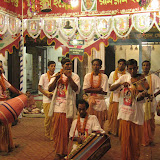I just realized that this blog is set to timestamp my entries based on US eastern time zone (GMT -5). Since we are at GMT +6 here, all my posts are actually happening a half day after the time stamp indicates! (Just add 11 hours)
Yesterday, Anne gave me a tour of Shankari Bazzar. It is an old Hindu neighborhood that is the home for a community that dates back several hundred years. Observant family members will remember her informed entry on the Peale family blog. This community is one of the last surviving Hindu artisan groups in the area. Most Hindus left during separation. They make shankari, beautiful conch shell bracelets that are worn by Hindu brides. Each bracelet is painstakely carved from a conch shell from artisans working in impossibly small spaces. Anne and I both purchase a pair - if we can get them back onto our wrists, you will see an example! The shop owner squeezed our hands into the smallest size possible. Our best guess is that this is somewhat akin to Scarlett O'Hara being squeezed into the smallest corset possible - smaller is better and more feminine. With our large western hands, we still had some of the largest bracelets available!
The bazzar itself is a short, narrow street that is only about 2 US city blocks long. On this day, it was incredibly crowded with rickshaws and people. On our first pass of the street, it was all I could do not to get my sharlwar kamese caught in the wheels of a rickshaw! Thus, there are only a few photos. Our walk was made more difficult by the primitive nature of the area. These buildings are at least 400 years old and they have not been updated with modern conveniences. Like many areas of Dhaka, it was a glimpse into what life was like in most of the world just a short time ago. The roadside was full of household scraps. There were partially open "gutters" on both sides of the road. There are also two Hindu shrines on this street, both of which stop pedestrian traffic. All of these added to the number of road hazzards! The first pass through was definitely overwhelming.
As we made our way back to the car (second pass), we stopped to purchase the bracelets. Stopping and sitting for a spell helped us catch our breath (this was busy even for Anne) and it let the residents stop, stare, and get used to us. (We had collected the usual parade of curious Deshis.) After leaving the shop, making our way was a bit easier. We even ran into the guide from the boat trip yesterday! It almost made Dhaka seem like a small town. We were just about to the car when a Deshi stopped us and admired our bracelets. He introduced himself as a banker and as a Hindu. He told us that if we were to visit the Hindu neighborhood that we should take time to see the Kalipuja (Festival of Khali) happening right at that moment. He told us that a music group was performing religious songs. Normally, you don't go following random people. But here, if someone wants to show off their culture to westerners they are pretty genuine. (there was also a police barack close by...) He took us back down Shankari Bazzar (third pass). He took us down an alley just at the end of the road and after a few steps we saw the large fabric archway and festival tent. It was beautiful! He told us that this festival lasts 9 days and continues 24 hours a day. It is hard to describe the atmosphere in the tent. The air was full of incense and the music was haunting. Everything was vividly colored and beautiful. The crowd was reverently silent. However, no amount of tiptoeing or silence could prevent two white women from disrupting everything. After getting permission to take photos, I quickly snapped a few and we moved on. Our driver was waiting and no one was paying attention to the musicians (even they were staring at us).
The quickest way back was around the block and down an even narrower alley. Through practice and by following our guide, Anne and I finally got the Shankari Bazzar traffic mojo. On our final trip through the bazzar (fourth pass), we were deftly moving through traffic. The trick is to place yourself in between the the back wheels of the the bumper to bumper rickshaws. Effectively, you are walking right next to the front wheel. You can pass when you find a wider spot in the road and move even more quickly when you reach a break in the rickshaws. If you are good, you can keep your pedicure nice and neat at the same time (you are in sandals, of course).
Shankari Bazzar itself is in danger. The Bangladeshi government has condemned the buildings as unsafe and they are scheduled for destruction. There are local architects that are working with the shankari community and the government to help save what remains of the architectural and cultural heritage of this area of Dhaka. Anne wrote about this extensively in their blog, so I will not repeat it here. My hope is that if more westerners show interest in this area as a tourist destination, the locals will come to view it as an important site for preservation.
Saturday, February 10, 2007
Subscribe to:
Post Comments (Atom)

2 comments:
I noticed that one of the pictures showed a rickshaw with the pictures of a couple of women on the back ---one without a scarf. Is that considered sexy?
Good question! I don't know if it is sexy per se, but we have been told that the people on the rickshaws are Deshi movie stars.
Post a Comment